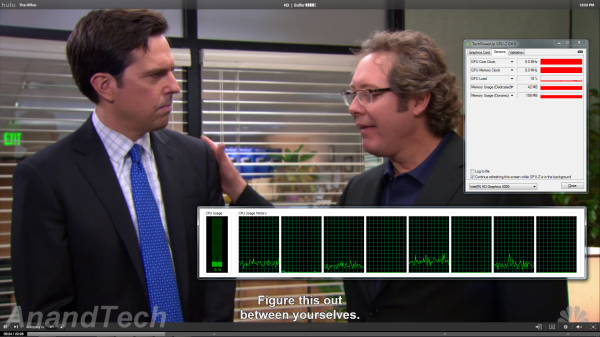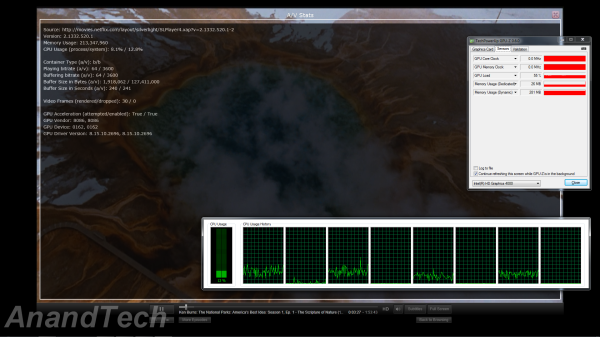Intel's Ivy Bridge: An HTPC Perspective
by Ganesh T S on April 23, 2012 12:01 PM EST- Posted in
- Home Theater
- Intel
- HTPC
- Ivy Bridge
The last time we looked at Flash acceleration in the Intel drivers, we came away disappointed. Have things changed this time around? Intel seems to have taken extra care about this aspect and even supplied us with Flash player builds confirmed and tested to have full GPU acceleration and rendering capabilities. We took the Flash plugin for a test drive using our standard YouTube clip. This time around, we also added a 720p Hulu Plus clip. In the case of YouTube, there is visual confirmation of accelerated decoding and rendering. For Hulu Plus, we need to infer it from the GPU usage in GPU-Z. Hulu Plus streaming seems to be slightly more demanding on the CPU compared to YouTube.
Netflix streaming, on the other hand, uses Microsoft's Silverlight technology. Unlike Flash, hardware acceleration for the video decode process is not controlled by the user. It is upto the server side code to attempt GPU acceleration. Thankfully, Netflix does try to take advantage of the GPU's capabilities.
This is evident from the A/V stats recorded while streaming a Netflix HD video at the maximum possible bitrate of 3.7 Mbps. The high GPU usage in GPU-Z also points to hardware acceleration being utilized.













70 Comments
View All Comments
Midwayman - Wednesday, April 25, 2012 - link
Have you ever seen a 4k display on a uncompressed signal? The clarity is just astounding.I'm more concerned about the ability to deliver content with that kind of bandwidth requirements. We already get hdtv signals that are so compressed that they're barely better than a really really good SDTV signal.
MobiusStrip - Friday, April 27, 2012 - link
Most of what you see labeled "HD" (or variants thereof) is marketing bullshit. You're not getting HD when the bitrate is 3 megabits per second, especially when anything on the screen is moving.You can blow a VHS picture up to "HD" resolution, and it won't be HD. That's exactly what's happening in most consumer devices today.
"4K" is rapidly emerging as the next fraud. We'll see the same crap blown up to 3840 x whatever (barely even 4K by any standard), but containing 1K of real resolution if you're lucky.
The era of increasing quality is over, as consumers prove over and over that they don't care about quality.
A5 - Monday, April 23, 2012 - link
"Otherwise, the Ivy Bridge platform has everything that a HTPC user would ever need."I'd like an open-source (or at least) free encoder that supports QuickSync and not having to be picky with my DRAM purchase to use GPU-accelerated decoders before I say that.
Other than that, it seems to be good enough for the basic HTPC functionality - can't wait for the new i3s and Pentiums to see if the low-end parts are good enough!
ganeshts - Monday, April 23, 2012 - link
You can use GPU accelerated decoders even with DDR3-1333 DRAM. You need to go high speed / low latency only if you want rendering through madVR.Use QuickSync Decoder or DXVA2 Native in LAV or MPC Video Decoder + EVR-CP to get full decode and rendering acceleration without worry about the DRAM.
babgvant - Monday, April 23, 2012 - link
DVRMSToolbox (DTB) has included a QS capable transcoding solution for over a year. The main benefit to using it vs. the other retail options is that it supports EDL files during transcoding.DTB is FOSS, the QS dlls are just FSS.
A5 - Monday, April 23, 2012 - link
Cool stuff. Hadn't heard of your tool before today, I'll make sure to check it out when I get my HDHR Prime from Woot.shawkie - Monday, April 23, 2012 - link
I've experimented with madVR a bit but in the end the problems with playing back DVDs and Blu-rays with menus has so far stopped me from using it seriously. However, I've seen reports claiming that Ivy Bridge includes higher quality upscaling within Windows Media Player (as part of the EVR I suppose). Any evidence of this?ganeshts - Monday, April 23, 2012 - link
You can take a look at the PowerDVD chroma upscaling screenshots linked in the text. I was really surprised at the quality (until I zoomed to 300%, I couldn't actually decipher the difference between PowerDVD and madVR!). Similar behavior with MPC-HC using MPCVideoDec.Btw, can you link me to the reports that you mention?
shawkie - Monday, April 23, 2012 - link
http://www.intel.com/content/www/us/en/architectur...This was one of them. I also found a comment from one of the engineers that explained that they were using a higher quality upsampling algorithm too but I can't find it now.
ganeshts - Monday, April 23, 2012 - link
Andrew @ MissingRemote just refreshed my memory about this post by Eric Gur: http://forum.doom9.org/showthread.php?p=1551981#po...